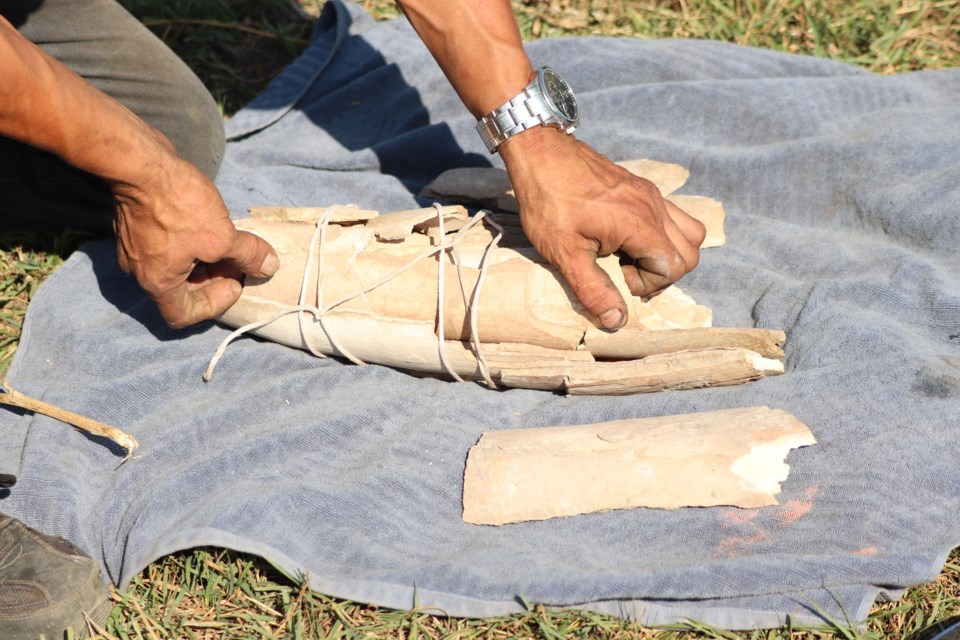LAKELAND, Alta. – A Royal Alberta Museum curator says he hopes to one day be able to take a look at the mammoth tusk found recently in Saddle Lake.
“The tusk find is pretty amazing because tusks aren’t overly common in the record in Alberta,” says Chris Jass, a curator of ice age paleontology at the Royal Alberta Museum. “The pictures look great, but it’s always nice to see those objects in person.”
Jass grew up in the United States before moving to Canada. When he was eight years old, his uncle took him out to collect fossils in the area where he grew up. This was when his interest in paleontology began.
When he was older, he began working at a museum in South Dakota where a site had been discovered with about 60 mammoths trapped in a sinkhole. “Working at that museum is what pushed me towards working on questions related to the ice age.”
Then, he moved to Canada and found Alberta to be a unique place to work and study paleontology due to its geologic history.
Within the ice age that began around 2.6 million years ago, Jass says there were both cold, glacial timeframes and warmer interglacial cycles that occurred.
He says the record of mammoths and other big ice age animals curated at the Royal Alberta Museum did not come from a single period of history but spans throughout those cold and warmer interglacial cycles.
“That’s one of the reasons why we try to radiocarbon date a lot of the material we recover, because we’re trying to understand exactly when those populations of mammoths were here,” explains Jass.
Alberta’s geologic history of the last 150,000 years is tied to dramatic environmental and geological changes. Jass says before the last major advance of glaciers around 22,000 years ago, there was a different ecosystem that existed in Alberta where it may have been a landscape teeming with horses, more than any other big animals.
But among those other big animals are mammoths, and one of the focuses of the Royal Alberta Museum lies in “working towards understanding just how common [mammoths] were in Alberta during the ice age.”
When the last major glacial advance occurred, it resulted in ice covering much of the province, according to Jass. “Glaciers expanded from Northeastern Canada and they met up with glaciers coming out of the mountains and covered basically all of Alberta.”
When the glaciers retreated, Jass says the ecosystem changed, resulting in “a huge ecosystem disturbance.”
“You put ice across an entire landscape for a good period of time and then all of a sudden, that ice starts to retreat, and the landscape starts to open back up,” he describes. “Well, that gives us an opportunity to understand how animals respond to major environmental change.”
Thus, among the questions Jass looks to answer includes, “how do we go from landscapes that had mammoths, mastodons, and big extinct animals” to “what you see on the landscape when you walk out of your house today?”
“Basically, a big part of my job is to understand the ice age history of Alberta,” he says, particularly the ice age history of animals in the province like mammoths, mastodons, or giant short-faced bears. “Then, take that information and translate it into something palatable in a museum gallery, an outreach talk, or in a scientific publication,” says Jass, explaining paleontologist's scientific role and communication of “science to the public.”
“At its core, what we do when we study the ice age is try to put a historical perspective on the modern biota – the plants and animals that we see on the landscape today,” he says. “Studying the ice age allows us to understand how the landscapes that we have today came to be.”
Jass encourages people who find unique and interesting materials to contact the Royal Alberta Museum, and in fact, a lot of the research projects being worked on started because an Albertan found something unique and asked questions.
He also explains that the Historic Resources Act applies in Alberta, which means fossils or artifacts are considered Crown property, and they are part of a heritage shared by all Albertans. But there are some exceptions based on jurisdiction, “and the national parks and reserves fall outside of the provincial Historic Resources Act.” For example, the tusk found at Saddle Lake.
“What we encourage people to do is essentially what the folks did at Saddle Lake,” which means taking pictures of the material, and particularly where it was found. “You can take GPS coordinates and record that information, take a picture of it, and contact us,” even if it means the people who found said materials want to hang on to it for a while.
“Just record the information in terms of where it was found... that information about where it was found is often just as important as the object itself."




